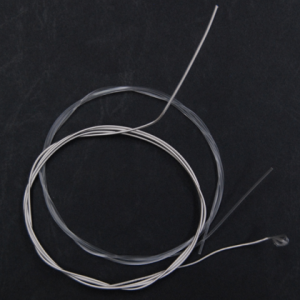
Classical and folk guitars require nylon strings so it’s important to know the types of nylon strings available. Nylon strings have a softer, more mellow tone and are usually used in classical, flamenco, samba and folk styles. These types of guitars are lightly braced internally and do not have any extra reinforcement built into their necks. Note that these these types of guitars can’t handle the extra tension of metal strings so you should NEVER use metal strings on these types of guitars as you will bow the neck and/or pull the bridge off. Our article on how to string a classical guitar can show you how to change strings on these guitars.
Nylon string sets use 3 nylon/plastic, usually clear, strings for the high E, B, and G strings. Low E, A, and D strings are wound with silver or brass around a nylon center.
Classical Guitar Strings

Classical guitar strings are plain on both ends. Installing them requires that you tie the string at the bridge by wrapping it around itself. Classical string sets will come as either normal/low-tension, moderate or high-tension which relates to your guitar neck’s ability to take different levels of stress. Beginning guitarists should purchase low-tension. This string set is the best-seller among all the types of nylon guitar strings available. The gauge (thickness) of a low-tension string is .028 of an inch. Higher tension strings are slightly thicker.
Folk Guitar Strings
Similar to classical, folk guitar strings feature three plain strings (usually black) for the lightest strings (G, B, and high E) and three wound strings. Folk strings are much lighter gauge (starting at .045 inch) than classical strings. Each folk string has a plastic ball on one end used to secure the string at the bridge.